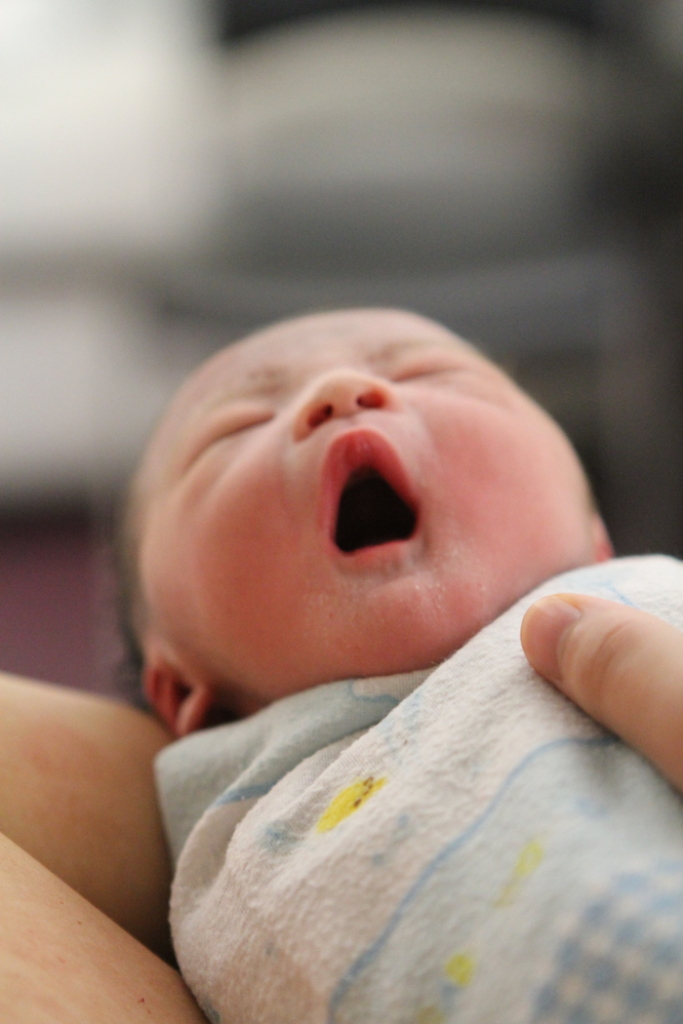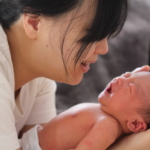AUTHOR'S NOTE: This is the second post of a three-part series of how little bao came into the world, and the days following his arrival. (You can read the first part through this link.) Just a warning: It's a lengthy one. The last word count of the total story is almost 12,000 words, but I'm hopeful in sharing mine, others can learn from it, or realise that they are not alone.

Day 1
The first shower after birth, they said, was the best shower you ever had. It was great, for sure. I was able to move normally, not even needing the bathing chair that was given for extra support, and I thought, naively, that probably this wouldn’t be that bad. After all, I had no nausea, very minimal swelling in the feet, and at that very moment, no pain. I was just sore. I dried myself and we were moved from the birth suite to the postnatal ward, where I underwent, frankly, the darkest three days of my life.
The room was small. I was taken aback, because from the maternity tour video it didn’t look this small. My husband would have to sleep on the most uncomfortable sofa bed I had ever seen, and it even had to be moved from the original position and placed at an angle for it to open properly as there was literally no space.
We didn’t think beforehand to enquire for the double room. I thought it would probably be better for us to sleep separately, so at least one of us could sleep while the other attended to the baby. We spread out our essential belongings the best way we could—snacks here, pads there, electronics on the other side. We turned on the portable speaker for white noise, and tried to settle into the cold night.
That was when I realised that breastfeeding hurt, a lot.
Thing was, I knew for sure it was not supposed to be painful. I had read books and articles, countless forums and comments saying that it should not hurt. Apart from the initial latch, breastfeeding should just feel like a tugging sensation. Weird, maybe, uncomfortable, perhaps, but not painful. I thought that probably my nipples were just sensitive, that they hadn’t been used for this purpose until now, that they just had to toughen up.
One of the midwives came in when I tried to breastfeed, and provided advices on how to get him to latch better.
The baby should have opened his mouth bigger.
I know.
He’s meant to draw the nipple towards the back.
I know.
Then she tried to hand express my colostrum, but couldn’t see even a single glistening, a hint of something. Don’t worry, she said, it does take a while for your body to adjust. Your milk will come.
Okay.
I spent the next six hours worrying about little bao’s sugar level, because having had GDM meant that bao had to have three heel pricks every two hours, and he had to pass his sugar levels. Feeding colostrum was meant to help with regulating his blood sugar. Yet as far as I knew, I had none. I didn’t know whether he was getting anything when he was sucking—I could only hope he did.
He passed the first one: 3.1 (pass level was 2.6). I breathed a sigh of relief. Two hours after, it was 2.9. Okay, not ideal, but still a pass. The third one was so nerve-racking, because it was 2.6 on the dot.
Does he pass? I asked.
He does, the midwife said. A pass, even though on the dot, is still a pass. Congratulations.
One huge burden was lifted off my shoulders. But still I was worried, because his levels were getting down. That meant over the course of six hours, he was not getting the food he needed, or just barely enough food to keep his levels afloat. I needed him to eat.
I decided to worry about his food intake in the morning, because that night, I was hit with the after-effects of epidural the whole night: I was shivering violently.
I had been warned about this by my sister one week ago. It surprised her—the shivering—because she didn’t know. It didn’t surprise me, because I knew, but it didn’t mean that it wasn’t alarming. I requested extra blanket and it didn’t work. Every time I needed to go to the toilet, which was often as I needed to continually change the ice packs down below to reduce the swelling, I would shake and I could feel the cold right to my spine. My husband told me that the room was just too cold—he was feeling cold too; it wasn’t just me. As it was central cooling and heating, the midwife couldn’t do anything to the temperature.
I went to bed, still shaking, eager to sleep while the baby slept, but I couldn’t. I never was a great sleeper, even before and during pregnancy, and it usually took a while for me to fall asleep, but this was the next level. I had zero sleep the first night, shivering under the blankets until morning came. I saw my husband, exhausted, forced to sleep at a weird angle on the sofa bed, also feeling too cold. I looked at my baby and thought, The morning will be better. My milk will come. We’ll start over. We’ll ask the midwife again on how to latch properly. Perhaps my technique was just very poor.
We’ll get there.
Day 2
The other damning thing about the room was that the bathroom was arranged in a way that showering meant flooding the whole floor. There was no shower door, and as the bathroom was, you guess it, small, water would get splashed everywhere. I hated that bathroom. It was always damp, and cold, and I could see pads piling with blood, well, my blood, everywhere.
It was depressing.
I was served breakfast, and while I had no appetite, I forced myself to eat. I remembered that breastfeeding is a marathon, and I needed to eat healthily, and eat a lot, as well as drink an even more ridiculous amount of water in comparison to during my pregnancy. Having GDM meant drinking like a camel as water lowered my sugar level, but oh boy, I was drinking like two camels. Thankfully, my violent shivering had stopped, and my slightly swollen feet were almost back to normal. Still a bit puffier than usual, but nothing that hindered anything.
Most mums I know told me that newborns are very sleepy in the early days, that they could usually get a little bit of rest in the hospital—the real challenge starts at home. But little bao was unsettled throughout the day. He constantly fussed, demanding the breast every two hours, which I was told was normal, but I didn’t see him blissfully going to sleep in a milk-drunk face. He just seemed tired, passed out. The paediatrician came to check, and reassured us that everything was alright and well, that her only concern was his skin that looked a little bit jaundiced, but that was common. Little bao had the three-clicker jaundice check and passed, so she (the paed) told us that she would come back in two days just to check and assess him again. But he was gorgeous, he was healthy, and he was all good and well.
Still, we were worried.
I was taken care by three midwives that day, and while all was so lovely, all had different advices in regards to breastfeeding. One showed me a better way to get my baby into position. Bring the baby’s mouth to you, not the other way around. One told me to squeeze my breast before he latched, and to keep squeezing it, so that he would have a deeper latch. Another said that my latch seemed good—not ideal, but good enough, as she could still hear a clicking sound when he drank.
At least he is still sucking, I thought. But it hurt. A lot. All three midwives tried to hand express my colostrum, and all three failed.
By that evening, even my extremely nice and patient husband couldn’t stand the room anymore. He asked the receptionist whether we could move to a double room, and he came back saying that all double rooms were occupied—that we were put on a waiting list, but it wasn’t going to be tonight. Okay, I said. Hopefully tomorrow. My husband also said that the receptionist seemed annoyed that he bothered her with that request. Perhaps the maternity ward was really at the limit that weekend.
Little bao cluster fed the whole night. Every time I put him down, he cried. He constantly searched for the breast. When he slept, for, thirty minutes maybe, I couldn’t sleep. Postpartum insomnia hit me hard. He didn’t want to leave the breast, and by then, my nipple was bruised, bloodied, cracked, and sore. Every suck hurt. And I didn’t know whether he was getting anything, as I never saw a single drop of colostrum.
My little baby cried, and cried.
At dawn, a midwife came to check on me, finding me with a fussy baby who was clearly, even though she didn’t say it to my face, hungry.
Perhaps it’s time we use formula top up, she said. Just for a while, while waiting for your milk to come in.
Okay.
She prepared a bottle of 20 mls, and little bao devoured it all. Then he was asleep for more than three hours—the longest he had been asleep since birth.
Day 3
That was when—holding my contented, sleeping baby, in the early hours of the third day—I broke down and cried on the hospital bed, my husband sleeping on the sofa bed, uncomfortable, cold, and clearly exhausted. He had been waking up to fetch me ice and water constantly around the clock. He couldn’t sleep well. He was worried about bao, and worried about me. While he knew that the first days were going to be hard, he didn’t realise it was going to be this hard. Aren’t the hard days still months ahead, when baby undergoes growth spurt and no matter what you do, just cries into the night, refusing to be settled? If we were going to be the sleepless, zombie-like parents, it would be in the future, not now. Not when we were still in hospital, with an abundance of help around us.
My husband woke up to find me crying. Shocked and alarmed, he jumped out of bed and asked me what was wrong.
What’s wrong, I thought, is my decision to get induced. What’s wrong, I felt, is not letting little bao stay a bit longer in my belly, where nothing could ever harm him, not even his clueless mother who couldn’t feed him.
I broke down, again and again on all hours that day, and right when the tears flew at breakfast, a midwife came in. She sat down beside me, asking me what was wrong.
I just feel overwhelmed, I said. I don’t understand why my baby wouldn’t latch, why every suck hurt, why my milk hasn’t come. She told me that it’s very normal for milk to come later, at day three or even five.
Don’t be too hard on yourself, she said. As first-time parents, I know it’s hard. Have a good cry. Sometimes you just need to let it all out.
She advised me to go on the pump, to see whether it would stimulate my breasts to produce milk faster.
And it’s okay to introduce formula, she reassured. Your baby will not be harmed. He will still take your breast. He will not have nipple confusion.
Your milk will come, she looked at me warmly, I promise.
I nodded. And in between the tears, I nodded again.
An hour later, the midwife had another good news: Our double room was ready. I would never know whether we got the room because of the tears or not, but I was so grateful to leave the single room. I wasn’t coping. I hadn’t slept for 36 hours. My husband wasn’t sleeping. He was cold, all achey, and far away. The room was just too cold, with white light bulbs that gave no warmth, and no sunlight coming in.
The double room was, literally, double in size. There was a proper bed, and my husband could cuddle me to sleep if I want to, or need to. We had space to put all our stuff, and some more. I could breastfeed on the sofa, instead of sitting down on the hard mattress and aggravating my stitches.
I tried pumping for the rest of the day, although still not a single drop of milk would come out. My baby had more formula top-ups, and as he grew more contented, so did my guilt. The same midwife came in to see me in tears one more time. Again, she sat down beside me, asking me whether it was the breastfeeding again. I nodded.
It’s very normal for milk to come in late, she said. It doesn’t mean anything. It’s really hard, I know, but you’ll be okay. Your baby is healthy. I’ve put your name down for a lactation consultant to come in. I hope one will be around today. You can get help. It’s not your fault.
But, I thought, it’s all because of me. It’s because I let him be born before he was ready. Then he went to undergo fetal distress. I had significant blood loss. All these triggered the delay. My milk hasn’t come, and I don’t even have a single drop of colostrum to feed him. And my nipples hurt. A lot.
When the midwife left the room, my husband said that she looked emotional as well.
Little bao got weighed when he was exactly 48 hours old, and to our delight, he only lost six per cent of his initial body weight. That was a relief. The formula top up worked. He then had his first bath by a very nervous first-time Dad, and we felt his skin without vernix, without the gunk and dried blood on his hair. And we still didn’t know who he looked like. But we’ve finally decided on a name.
His name is Lionel Theodore Tan.
He is our little lion; he is strong and courageous, a name chosen based on the book of Joshua 1:9, for God will be with him wherever he goes—a name given by Dad.
And he would be our Theodore, our gift from God, as a reminder, for me, that even though his birth was traumatic, that even though the first few days of his life were filled with anxiety and tears, he is still our little blessing—a name given by Mum.
Throughout that night, I offered my baby the breast, then my husband prepared the 20 mls formula top up while I pumped. I religiously stuck to the pumping-every-three-hour rule, even throughout the night, and little bao was sleeping like clockwork, sleeping in three-, four-hour stretches, contented, full.
But I was still battling breastfeeding.
In my mind, I didn’t know how to go through this for long, as it hurt. Not like contraction pain, of course, but that pain had an end time. This one had not.
Little bao cried, again, at three in the morning while I offered him the breast, and another midwife came in to check. She offered to observe me on how I fed my baby, and told me that I should have lessened the hold on my breast after the first few sucks so that I wasn’t blocking the milk ducts. It made sense, but the other midwife had told me exactly the opposite. This midwife told me that I had the correct hold, but still she couldn’t tell me why my baby wasn’t latching properly, nor why it hurt.
Someone has booked a meeting with the lactation consultant for me, I said. Could you follow up?
Don’t worry, she said, I have left a voicemail on the lactation consultant’s phone. Hopefully she’ll be here in the morning.
Okay.
Okay.
When she left, I sat there on the sofa, pumping, while little bao was asleep, formula-milk-drunk, in his bassinet. My tears flowed again. But this time, I was determined. I took my phone and opened my notes. Tomorrow the paed would be giving another check. I listed down my questions. My obs would see me once more to see how I was going. I jotted down another set of questions. The lactation consultant would, hopefully, come. I wrote even more questions. I was determined to seek help, to find out the answers to my questions, to plan out my next step.
Day 4
I woke up feeling a little bit more refreshed. At least, after not sleeping for two days, I was able to get a cat nap here and there. It was still hard for me to fall asleep, but at some point, I did fall asleep. I took that as a win.
The lactation consultant came into the room right at the end of a feed. She took one look at my breasts and said it bluntly: You have trauma on your nipples. They were cracked, sore, damaged. But since I was at the end, she couldn’t figure out the problem. She needed to see the beginning—how the baby latched, how he sucked, how he swallowed. She told me to get pumping, three hourly, until my supply is established. She would also get the midwife on duty to try hand expressing milk—again—I hadn’t tell her that I never had a single drop. Then she told me that another lactation consultant was going to be around in the postnatal ward that day. She gave me her number, and told me to call her at the start of the next feed.
Not long after, my obs came into the room, checking me postnatally, double checking whether my stitches needed any attention, and how I was healing in the past few days.
All on track, she said, but don’t be alarmed if you still have pain or bleeding, as it’s normal until six weeks postpartum.
We then chatted about what happened in the delivery room—things I already knew but haven’t had that thorough conversation with her.
I picked up the fetal distress through the monitor, she said. Upon inspection, he was already down below and needed to get out quickly, and you did a wonderful job pushing. If you didn’t push, I wouldn’t be able to use the vacuum and get him delivered—it would be via emergency c-section, and the prep would be longer. The episiotomy was needed at the time because he needed to get out quickly as he was in distress, and we found out it was because of the cord around the neck. It’s all very normal. There are no long-term complications of using the vacuum. You had some blood loss but we were able to get the medication to work in time. Baby Lionel is gorgeous. Do you have any more question for me? Give me a call if you have any concern about anything, otherwise I will see you during the six-week check up.
The midwife on duty also came, and she was probably the seventh person who tried to hand express me. I was resigned to my fate that most likely nothing would come out.
But she did it.
She actually had a different technique, and I could see droplets straightaway. Is it colostrum? I asked. Or is it milk?
It is milk! She cheered. It is white and runny. Good job! Tell me if I’m hurting you as well. Do you want to try? You have to go two cms around the areola, in a c-shape hold. Good. Now press them towards the back, and while squeezing you bring them forward. That’s good! Keep going. You can also massage the milk ducts around the two cms above areola mark. No, you don’t have to massage it before every squeeze. Sometimes if you have found a good milk duct you can just keep squeezing multiple times. Oh, good job you.
That, was a turning point.
My milk came, albeit in small droplets. The midwife, this midwife, finally, had the right technique—one that I still use today. She told me that I was also doing a good job with keeping up with the ice, because the stitches looked so good. She would also follow up with me on the baby’s jaundice, as she needed to do another check later that evening just to see whether the levels were still acceptable.
His skin is just slightly yellow, she said, which is normal—he doesn’t look like a jaundiced baby to me.
Oh, that’s a relief.
So you’re doing a good job these past few days topping up with formula so your baby won’t have jaundice. It was needed at the time, but probably you don’t have to do it for long now that your milk has come in.
Oh, that’s very good to know.
I’ll see you for your afternoon check, but give the lactation consultant a call on your next feed. You’re doing a good job!
Thank you, I will.
Finally, at the next feed, the lactation consultant came. She sat down beside me on the sofa where I was trying to get my son to latch and suck. When he pulled off, she took one look at my nipples and told me straightaway that it’s not long enough for baby’s sucking.
It’s only getting in halfway, she said. It hurts because it doesn’t go all the way towards the back of his mouth. Put some breast milk on your nipple and try to air dry it to let it heal. Do you want to try and use a nipple shield? It can help your baby latch. Your nipple will change its shape as you continue on breastfeeding, so you might not need to use the shield forever.
So it wasn’t his latch, nor my technique that was wrong. It was just the shape of my nipple.
The best way to attach a nipple shield, she said, is to express a little bit of milk and put a drop onto it. Then put a little bit of breast milk on your areola as well, so it stays still. What you want to do is to put the nipple shield on the baby’s upper lip to get him to open his mouth.
Little bao latched on straightaway.
He seemed to be getting milk, as we could see droplets of milk inside the shield when he unlatched, and he was content after the feed. The consultant advised us to top up with any expressed breast milk first, then formula if he was still unsettled.
Pump every three hours, she said, it would increase your supply. Let baby get on your breast for as long as he likes, whenever he wants. Strip his clothes and do skin-to-skin; put him on your chest so it would trigger his reflex to search for your breast. If he falls asleep, try blowing air into his face, tickling his feet, or squeezing your breast gently in between the sucks. I’ll book you in for a follow up consultation next week and we’ll assess from there. How does that sound?
Sounds terrific.
My baby latched. Breastfeeding didn’t hurt anymore. And my milk came.
Another turning point.
Finally, I could breathe a little easier. I could feed my baby.

Day 5 and Beyond: Home
We were discharged from the hospital the next morning. Little bao’s skin still looked a little bit yellow, but he passed his jaundice readings, so again, I was relieved.
Finally, we were going home.
And it would be just the three of us.
We had to stop at the pharmacy to pick up bits and pieces: A tin of formula, a pair of contact nipple shields, vitamin D for infants, bottles—we had bought a few, but I would need more, as now I needed to do top ups—and other bits and pieces. It felt weird, to come to the shop with a second trimester belly, yet you were buying formula and bottles—you’ve had your baby.
It was nice being home. Yet we didn’t rest. We couldn’t. Our first day back, I’ve turned on the stove and cooked. Yes, I had food in the freezer. But we still needed vegetables, and vegetables couldn’t be frozen, so here I was, five days after giving birth, chopping and stir-frying veggies, and making steamed eggs. My husband did one laundry load after the other, washed dishes, and tried to unpack all the stuff we had just, well, stuffed, into our luggages from the hospital.
In between feeds, I rummaged the cupboard for breast pump and steriliser I had borrowed from my sister, grabbed the baby bottle dishwashing liquid from the storage, and washed all of them. While I always knew I would use these equipments, I thought I would have time. I didn’t, and it was stressful. Luckily we had some leftover formula and a few single-use bottles from the hospital that we could use for one day. But that was it. A day’s grace. Tomorrow, we would need to have everything figured out.
So in between feeds, I tried to read through all the instruction manuals. I knew roughly how breast pump worked, having used one in the hospital, but for some reasons my sister’s hurt, and it didn’t provide the same suction like the hospital-grade one. But I persevered, all to build up my supply.
The steriliser was pretty much straightforward to use, although there was a section where you had to descale the product regularly, but it was a future Marcella problem. At the moment, I would just stick with making sure everything worked.
By the end of the day, we were exhausted. All we did was chores, and while my mental burden of little bao’s health lessened, the mental burden of running the household kicked in. I had to remember to not over-exert myself, to not bring heavy loads, to not bend down and pick things up from the floor. I continually asked my husband to do me a favour, one after the other, like a broken record, repeatedly saying, “Hunny, can you help?” He would jump at a moment’s notice and do it, be it picking up stuff, fetching me water, heating up my heatpack as I couldn’t move from my position or else little bao would unlatch. But he, too, was exhausted. We had minimal sleep and overused brains, yet the house was in chaos.
And I noticed some other things about little bao: He was hot and red (but thankfully no fever, we checked), and he didn’t have enough wet nappies. By now, he should have six heavy wet nappies in 24 hours. He only had three scant ones, and they were somewhat concentrated in colour. His cries were tearless. I panicked again. Was he dehydrated? Did we need to increase the amount of formula?
That night, we had to learn to stop and just rest. I think I cried again. I cried a lot these days. Ah, baby blues.
The next day, still being so sleep deprived, we had the same amount of chores, or perhaps more. My husband did another load of laundry. I noticed that instead of going up, the mls of my expressed breastmilk from the pump went lower. I cried again at lunch. And my nipples hurt, now instead from the latching, it was from the pump. And no matter what I did, the flange wouldn’t do a tight seal around my breasts, so I had to press them tightly for the whole fifteen minutes of pumping.
Was it really this hard for everyone?
I hadn’t even replied to friends and families who congratulated me on the arrival of our bundle of joy, because frankly I didn’t have the mind-space to even talk to them. Everyone seemed worried about me, which was understandable—I was usually the most talkative person ever, posting updates here and there, and yet all everyone got from me was silence. Friends started reaching out, but I couldn’t even look at the messages.
During feeds, I was constantly Googling information. How wet should a “wet nappy” be? How many wet and dirty nappies should a newborn have in a day? What are the signs of dehydration? Is my baby getting enough milk? How many feeds should a newborn have? How long should each session last? How many degrees is fever in infant? Do you need to sterilise bottles on expressed breast milk? How long does breast milk last in the fridge?
Does pumping hurt?
In the end, I dismantled all the breast pump parts, cleaned them thoroughly and gave it another shot. It still hurt a lot, the suction was weird, and it wouldn’t perform a tight seal. I almost cried, but I swallowed the tears. I couldn’t go into another breakdown.
That was when I realised that my nipple had been damaged, no longer by my baby’s latch, but by the pump. The flange wasn’t the right size for me. And I had been forcing it to work for two days.
Of course it hurt.
It was so freeing, knowing the root of the problem. Now that I knew, I could work on a solution: Get a flange of the right size. I thought I would just persevere with the pump for the next few days, as I didn’t want to stop increasing my milk supply. But then my husband intervened: I was not to pump. If it hurt, and it really did, it wouldn’t do me any good. He was stern, telling me to just rest. We could use the formula top up in the meantime.
Wait for the parts, he said, then start trying again.
I agreed in defeat. I fed my little boy and texted my sister, asking for advice about the formula top ups, and whether I would need to increase it due to the number of wet nappies, or just leave it, or any other tip.
Thing is, I said, little bao doesn’t seem unsettled after feeding. He doesn’t cry asking for more. But he barely has wet nappies.
My sister told me that my volume of top up seemed a lot, in comparison to hers back then—but that it should be okay, since he would be weighed next week during the Maternal Child Health Nurse visit, and the nurse would advise whether to stop or decrease the top up according to the weight gain. Her baby also didn’t fuss after a feed, but needed constant feeding and had been dropping in weight, hence the top up.
Okay.
Since breastfeeding didn’t hurt anymore, I decided to just try for the rest of the day: I would cease all top ups, and not pump. Whenever little bao wanted to feed, even when it wasn’t the three hourly time yet, he would get fed. We’d see.
And it worked.
As if it was a vengeance, little bao cluster fed for the next two days. From 5 PM onwards that day, he was at the breast, on and off, until midnight, and pretty much the whole day the next day. But it paid off.
There were only three very concentrated wet nappies the day before. That day, he had five, albeit still minimal amount, and still a tad concentrated. The next day, he had six, and the day after, eight. And finally they were pale in colour.
The house was also finally in order. We didn’t have to do big chores for a while. I gained confidence on how to hold and feed little bao, on knowing his signs of hunger before he started wailing. I became more efficient at nappy changes, even though he still cried a lot during those times. When he had his first ‘peeing’ accident, which I had been warned by every mum who’s had a baby boy, I was honestly elated, knowing that he finally had enough to drink.
On day seven, we were finally settled. We could turn on the TV, and actually watched a movie in peace. My husband could shower his little boy with more cuddles and kisses, knowing that we didn’t have to worry too much about his health in the meantime. Little bao became more alert, more content, as the day went by.
It was such a learning curve—the first week of a baby’s life. And it was really, really hard. But it did get better.
This too shall pass.









